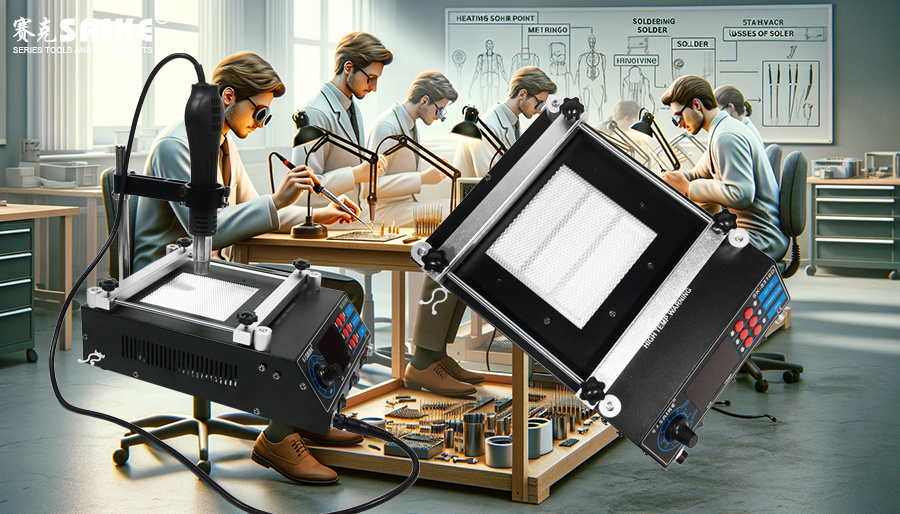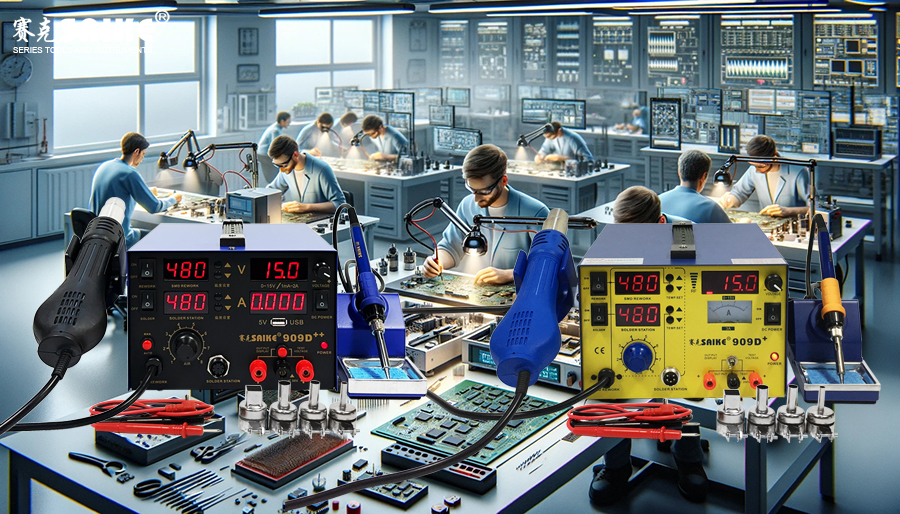
SK-YJ000RFSHY-KP 100023
Soldering is a technical task that requires precise operation and patience. Whether you’re a professional electronic engineer or a hobbyist, mastering proper soldering techniques is crucial. This article will delve into the details of proper soldering posture, methods for heating solder, and the correct usage of solder.
I. Proper Soldering Posture
Adopting the correct soldering posture not only enhances soldering accuracy and efficiency but also reduces the risk of fatigue and injury.
1.Sitting and Standing Postures
– Sitting: Choose a comfortable chair, keep your feet flat on the ground, and maintain a straight back. The workbench should be at a moderate height, positioning the soldering work area slightly below eye level. This helps reduce neck and back fatigue.
– Standing: If you prefer to solder while standing, keep your feet shoulder-width apart for balance. Maintain a similar workbench height as in the sitting posture, ensuring your arms can naturally hang down during operation.
2.Hand Posture
– Holding the Soldering Iron: Grip the soldering iron like a pen, with your fingers close to the tip for better control. Form a stable triangle with your thumb, index finger, and middle finger.
– Supporting the Arm: Rest your wrist or forearm on the workbench for stability. This aids in precise control of the soldering iron’s movement.
3.Eyes and Head
– Eye Alignment: Keep your eyes aligned with the soldering point, avoiding excessive head tilting. Using a magnifying glass or a lighted magnifier can help you observe details more clearly.
– Head Position: Maintain a natural upright head position, avoiding prolonged neck bending to reduce fatigue.
II. Methods for Heating Solder
Proper heating of solder is key to ensuring soldering quality. Both overheating and underheating can lead to poor soldering results.
1.Choosing the Right Temperature
– Soldering Station Temperature Setting: Generally, set the soldering station temperature between 300°C and 350°C. Adjust the temperature based on the type of solder and the materials being soldered.
– The melting point of common lead-containing solder wire is about 183°C, while lead-free solder has a melting point of about 217°C.
– Too low a temperature prevents the solder from fully melting, resulting in cold solder joints, while too high a temperature can damage electronic components and solder pads.
2.Heating the Soldering Point
– Heating Sequence: First, place the soldering iron tip on the soldering point, making contact with both the pad and the pin. Keep it there for a few seconds to preheat the soldering point.
– Adding Solder: After preheating the soldering point, gently feed the solder wire into the soldering point. The solder should quickly melt under the combined action of the soldering iron tip and the soldering point.
3.Maintaining Heat
– Stable Heating: Keep the soldering iron tip on the soldering point for at least 1-2 seconds to ensure the solder fully melts and flows over the soldering point.
– Avoiding Overheating: Don’t keep the iron on the point for too long to prevent overheating and potential damage to components or solder pads.
III. Proper Usage of Solder
Using solder correctly can enhance soldering quality and extend the lifespan of electronic devices.
1.Choosing the Right Solder
– Type of Solder: Select the appropriate type of solder based on soldering requirements. Lead-containing solder is easier to handle but restricted by environmental regulations, while lead-free solder is environmentally friendly but slightly more challenging to work with.
– Solder Diameter: Choose the appropriate diameter of solder wire based on the soldering object. The typical diameter ranges from 0.5mm to 1.0mm.
2.Controlling the Amount of Solder
– Adequate Solder: Use a moderate amount of solder. Too much can form solder balls, while too little may result in weak soldering.
– Solder Position: Ensure the solder evenly covers the soldering point, forming a smooth solder joint.
3.Storing Solder Wire
– Preventing Oxidation: Store solder wire in a dry, sealed container to prevent oxidation.
– Cleaning the Soldering Iron Tip: Regularly clean the soldering iron tip to remove oxides and residues, ensuring good thermal conductivity.
IV. Conclusion
Mastering proper soldering posture, methods for heating solder, and the correct usage of solder are key to enhancing soldering quality. Adopting the right posture reduces fatigue and enhances efficiency. Proper heating ensures reliable solder joints, and correct solder usage avoids soldering defects. We hope this article guides you in performing better electronic soldering tasks.


